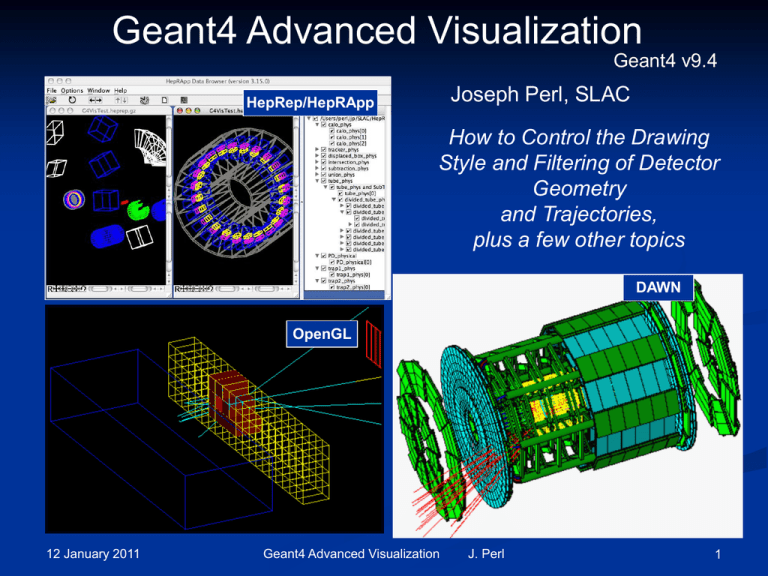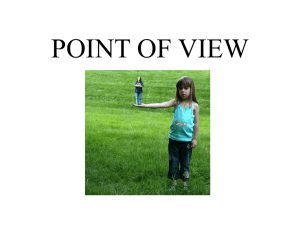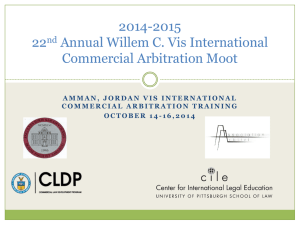G4VisAdvanced
advertisement

Geant4 Advanced Visualization
Geant4 v9.4
Joseph Perl, SLAC
HepRep/HepRApp
How to Control the Drawing
Style and Filtering of Detector
Geometry
and Trajectories,
plus a few other topics
DAWN
OpenGL
12 January 2011
Geant4 Advanced Visualization
J. Perl
1
Contents
Visualization Attributes
to control color, line style, etc.
to represent particle type, charge, etc.
Trajectory Modeling
Advanced Trajectory Modeling
Trajectory and Hit Filtering
Additional Topics
Controlling level of detail in geometry
Section planes
Reviewing kept events
Standalone visualization
12 January 2011
Geant4 Advanced Visualization
J. Perl
2
How this Document Fits with
Other Tutorial Materials
This presentation can be used on its own, but gives the most comprehensive
introduction to Geant4 visualization when used as part of the following full set of
documents:
Introduction to Geant4 Visualization
Geant4 Installation Guides
Geant4 Visualization Tutorial using the HepRApp HepRep Browser
Geant4 Visualization Tutorial using the DAWN Event Display
Geant4 Visualization Tutorial using the OpenGL Event Display
Geant4 Visualization Commands
Geant4 Advanced Visualization
See the URLS at the end of this presentation
12 January 2011
Geant4 Advanced Visualization
J. Perl
3
Visualization Attributes
12 January 2011
Geant4 Advanced Visualization
J. Perl
4
Two Kinds of Visualization Attributes
G4VisAttributes - carry standard drawing information:
Color
Visible/Invisible
Wireframe/Solid, etc.
HepRep-Style Attributes - carry arbitrary, user-defined
information:
for trajectories:
for hits:
momentum
particle type, etc.
energy
electronics channel number, etc.
for geometry volumes:
12 January 2011
logical volume name
material, etc.
Geant4 Advanced Visualization
J. Perl
5
G4VisAttributes
G4VisAttributes - carry standard drawing information:
Color
Visible/Invisible
Wireframe/Solid
etc.
For the first half of Geant4’s life,
these were the only kind of Visualization Attributes
12 January 2011
Geant4 Advanced Visualization
J. Perl
6
LineStyle: WireFrame or Solid
WireFrame
Solid
12 January 2011
Geant4 Advanced Visualization
J. Perl
7
Setting Geometry Vis Attributes from C++
Create G4VisAttributes object and assign it to a volume:
experimentalHall_logical -> SetVisAttributes
(G4VisAttributes::Invisible)
12 January 2011
Geant4 Advanced Visualization
J. Perl
8
Setting Geometry Vis Attributes from
Commands
You can control the color, linewidth and other attributes
of detailed geometry drawing using /vis/geometry
commands such as:
/vis/geometry/set/colour <myvolume> blue
For the full set of options, see the built-in command guidance.
A few more examples:
Change the line style of a particular volume to dashed
Change the line width of all volumes to 3
/vis/geometry/set/lineStyle <myvolume> dashed
/vis/geometry/set/lineWidth all 3
Change the number of line segments used to approximate a
circle for all volumes to 100
12 January 2011
/vis/geometry/set/forceLineSegmentsPerCircle all 0 100
Geant4 Advanced Visualization
J. Perl
9
Setting Overall Vis Attributes from Commands
While the previously shown /vis/geometry commands allow the
most detailed control over geometry drawing,
the /vis/viewer commands allow you to control a few overall settings
/vis/viewer/set/style wireframe
/vis/viewer/set/globalLineWidthScale
etc.
see online command guidance for details
Watch out for fact that interactive commands do not override C++
or /vis/geometry commands that have the “force” prefix, such as:
experimentalHallVisAtt->SetForceWireframe(true)
or
/vis/geometry/set/forceSolid experimentalHall
12 January 2011
Geant4 Advanced Visualization
J. Perl
10
HepRep-Style Attributes
HepRep-Style Attributes - carry arbitrary, user-defined information:
for trajectories:
for hits:
energy
electronics channel number, etc.
for geometry volumes:
momentum
particle type, etc.
logical volume name
material, etc.
These attributes were added to Geant4 over the last few years to
support advanced features in the HepRep browsers (HepRApp,
Wired4 and FRED).
display the attributes when you click on the graphics object
perform cuts on these values
label objects by these values
12 January 2011
Geant4 Advanced Visualization
J. Perl
11
HepRApp: Pick to Show Physics Attributes
Picked on this
volume to show
•Material
•Density
•Radlen
•etc
Picked on this
trajectory to show
•Particle ID
•Charge
•Momentum
•etc.
12 January 2011
Geant4 Advanced Visualization
J. Perl
12
HepRApp: Labeling by Any Attribute
12 January 2011
Geant4 Advanced Visualization
J. Perl
13
HepRApp: Cut by Any Attribute
12 January 2011
Geant4 Advanced Visualization
J. Perl
14
HepRep Attributes beyond the HepRep Browsers
Other visualization drivers can also use the HepRep-style attributes:
Open Inventor will show the attributes when you click on the relevant object
OpenGL also does this, with attributes shown in standard output window
Advanced visualization features described later in this presentation also use
HepRep attributes and work for all Geant4 visualization drivers:
Trajectory Modeling
Trajectory and Hit Filtering
12 January 2011
Geant4 Advanced Visualization
J. Perl
15
Defining Your Own HepRep Attributes
While a useful set of attributes is already defined by default in the standard
Geant4 trajectory, you are also free to define your own attributes:
std::map<G4String,G4AttDef>* store =
G4AttDefStore::GetInstance("G4Trajectory",isNew);
G4String PN("PN");
(*store)[PN] = G4AttDef(PN,"Particle Name","Physics","","G4String");
G4String IMom("IMom");
(*store)[IMom] = G4AttDef(IMom, "Momentum of track at start of trajectory",
"Physics","","G4ThreeVector");
Then fill the attributes with lines such as:
std::vector<G4AttValue>* values = new std::vector<G4AttValue>;
values->push_back(G4AttValue("PN",ParticleName,""));
s.seekp(std::ios::beg);
s << G4BestUnit(initialMomentum,"Energy") << std::ends;
values->push_back(G4AttValue("IMom",c,""));
See geant4/source/tracking/src/G4Trajectory.cc for a good example.
12 January 2011
Geant4 Advanced Visualization
J. Perl
16
Trajectory Modeling
12 January 2011
Geant4 Advanced Visualization
J. Perl
17
Enhanced Trajectory Drawing
Ability to change trajectory drawing model through interactive
commands
Lets you, for example,
declare that trajectories should be color-coded by charge,
then change to have them color-coded by particle type
Eliminates the most common reason users had to code their own
trajectory classes
Most examples include a vis.mac that demonstrates some of these
features
12 January 2011
Geant4 Advanced Visualization
J. Perl
18
Example A01, five events, drawBy various models
Creator Process
Charge
—
—
—
12 January 2011
+1
0
-1
—
—
—
—
—
muIoni
Decay
annihil
eIoni
brem
Geant4 Advanced Visualization
J. Perl
Momentum (MeV)
—
—
—
—
—
—
0-1
1-10
10-20
20-30
30-50
50+
19
Standard Models Supplied with Geant4
drawByCharge
drawByParticleID
Blue
-1
Red
0
Green
Colors trajectories according to particle type
All trajectories are colored grey by default
Configure to highlight chosen particle types with chosen colors
No limit on the number of particle types that can be highlighted
Colors trajectories according to volume in which they originated
for example, to highlight all particles that backscattered from a particular collimator
generic
+1
drawByOriginVolume
Default model
Colors trajectories according to charge
Draws all trajectories the same
control over more than just color, including:
Whether to show trajectory as line, step points or both
width of trajectory lines, type of marker to use for points, point size, etc.
12 January 2011
Geant4 Advanced Visualization
J. Perl
20
Model Configuration
You can create and configure multiple models through either
Interactive commands
Compiled code
Interactive commands
Located in /vis/modeling/trajectories directory
Possible to have multiple instances of given model type
e.g., toggle between two different ways of coloring by charge
List and select instantiated models with commands:
/vis/modeling/trajectories/list
/vis/modeling/trajectories/select <model-instance-name>
Note that detailed help for a given model is not shown in the help system until
you have created an instance of that model
e.g., only after you do your first:
/vis/modeling/trajectories/create/drawByCharge
will the help system will include details on drawByCharge
12 January 2011
Geant4 Advanced Visualization
J. Perl
21
Trajectory Modeling Examples
Example macro
#Standard setup
/vis/scene/create
/vis/open OGLIX
/vis/scene/add/volume
/vis/scene/add/trajectories
/vis/scene/add/hits
/vis/viewer/set/lightsThetaPhi 90. 0.
/vis/viewer/set/viewpointThetaPhi 150. 90.
/vis/viewer/set/style surface
/vis/viewer/set/hiddenEdge true
#Create drawByParticleID model, highlighting photons
/vis/modeling/trajectories/create/drawByParticleID
/vis/modeling/trajectories/drawByParticleID-0/set gamma
red
/run/beamOn 1
…
#Create drawByCharge model, coloring neutrals white
/vis/modeling/trajectories/create/drawByCharge
/vis/modeling/trajectories/drawByCharge-0/set 1 blue
/vis/modeling/trajectories/drawByCharge-0/set -1 red
/vis/modeling/trajectories/drawByCharge-0/set 0 white
/run/beamOn 1a
12 January 2011
Geant4 Advanced Visualization
J. Perl
22
More Sample Commands: drawByParticleID model
# Create a drawByParticleID model named drawByParticleID-0
/vis/modeling/trajectories/create/drawByParticleID
# Configure drawByParticleID-0 model
/vis/modeling/trajectories/drawByParticleID-0/set gamma red
/vis/modeling/trajectories/drawByParticleID-0/set proton yellow
/vis/modeling/trajectories/drawByParticleID-0/setRGBA e+ 1 0 1 1
Note that if you just select drawByParticleID but don’t do any commands to set colors,
all particles will be grey.
In future releases (starting with 9.4Beta1), default will be better:
/vis/modeling/trajectories/drawByParticleID-0/set e- red
/vis/modeling/trajectories/drawByParticleID-0/set e+ blue
/vis/modeling/trajectories/drawByParticleID-0/set proton cyan
/vis/modeling/trajectories/drawByParticleID-0/set gamma green
/vis/modeling/trajectories/drawByParticleID-0/set neutron yellow
/vis/modeling/trajectories/drawByParticleID-0/set pi+ magenta
/vis/modeling/trajectories/drawByParticleID-0/set pi- magenta
/vis/modeling/trajectories/drawByParticleID-0/set pi0 magenta
12 January 2011
Geant4 Advanced Visualization
J. Perl
23
More Sample Commands: drawByCharge Model
and Toggling Between Two Models
# Create a drawByCharge model (will get default name of drawCharge-0)
/vis/modeling/trajectories/create/drawByCharge
# Create another drawByCharge model with an explicit name of testChargeModel
/vis/modeling/trajectories/create/drawByCharge testChargeModel
# Configure these two drawByCharge models and visualize using either one of them
# Configure drawByCharge-0 model
/vis/modeling/trajectories/drawByCharge-0/set 1 red
/vis/modeling/trajectories/drawByCharge-0/set -1 red
/vis/modeling/trajectories/drawByCharge-0/set 0 white
# Configure testCharge model (showing different way of setting colors)
/vis/modeling/trajectories/testChargeModel/setRGBA 1 0 1 1 1
/vis/modeling/trajectories/testChargeModel/setRGBA -1 0.5 0.5 0.5 1
/vis/modeling/trajectories/testChargeModel/setRGBA 0 1 1 0 1
# List available models
/vis/modeling/trajectories/list
# select drawByCharge-0 to be current
/vis/modeling/trajectories/select drawByCharge-0
12 January 2011
Geant4 Advanced Visualization
J. Perl
24
Trajectory Modeling by HepRep-Style Attributes
For even greater flexibility, you can model the trajectory based on any of
the HepRep-style attributes, whether it is one of the default ones or an
attribute that you have defined for yourself.
E.g., set color based the value of the attribute CPN (for “creator process name”)
/vis/modeling/trajectories/create/drawByAttribute
/vis/modeling/trajectories/drawByCharge-0/verbose true
/vis/modeling/trajectories/drawByCharge-0/setAttribute CPN
Draw by the
attribute called
CPN
/vis/modeling/trajectories/drawByAttribute-0/addValue
/vis/modeling/trajectories/drawByAttribute-0/addValue
/vis/modeling/trajectories/drawByAttribute-0/addValue
/vis/modeling/trajectories/drawByAttribute-0/addValue
/vis/modeling/trajectories/drawByAttribute-0/addValue
Select relevant
attribute values
brem_key eBrem
annihil_key annihil
decay_key Decay
muIon_key muIoni
eIon_key eIoni
/vis/modeling/trajectories/drawByAttribute-0/brem_key/setLineColour red
/vis/modeling/trajectories/drawByAttribute-0/annihil_key/setLineColour green
/vis/modeling/trajectories/drawByAttribute-0/decay_key/setLineColour cyan
/vis/modeling/trajectories/drawByAttribute-0/eIon_key/setLineColour yellow
/vis/modeling/trajectories/drawByAttribute-0/muIon_key/setLineColour magenta
12 January 2011
Geant4 Advanced Visualization
J. Perl
Configure
visualisation
parameters
25
Example A01, five events, drawByAttribute models
Momentum (MeV)
Creator Process
—
—
—
—
—
12 January 2011
—
—
—
—
—
—
muIoni
Decay
annihil
eIoni
brem
Geant4 Advanced Visualization
J. Perl
0-1
1-10
10-20
20-30
30-50
50+
26
Trajectory Lines, Step Points, Regular and Smooth
Yellow are the actual step points used by Geant4
Magenta are auxiliary points added just for purposes of visualization
12 January 2011
Geant4 Advanced Visualization
J. Perl
27
Modeling Trajectory as Line, Step Points or Both
In the discussion of models up to now, we’ve only shown you how to set the
color, but a model can include many more options including whether to show
the trajectory as a line, a set of step points or both:
setDrawLine * Set draw line command
setLineVisible * Set line visibility command
setLineColour * Set colour through a string
setLineColourRGBA * Set colour through red, green, blue and alpha components
setDrawStepPts * Set draw step points command
setStepPtsVisible * Set step points colour command
setStepPtsColour * Set colour through a string
setStepPtsColourRGBA * Set colour through red, green, blue and alpha components
setStepPtsSize * Set step points colour command
setStepPtsType * Set step points type.
setStepPtsFillStyle * Set step fill style type.
(the following items relate to special kind of points discussed later under “smooth trajectory”)
setDrawAuxPts * Set draw auxiliary points command
setAuxPtsVisible * Set auxiliary points visibility command
setAuxPtsColour * Set colour through a string
setAuxPtsColourRGBA * Set colour through red, green, blue and alpha components
setAuxPtsSize * Set auxiliary points size command
setAuxPtsType * Set auxiliary points type.
setAuxPtsFillStyle * Set auxiliary fill style.
12 January 2011
Geant4 Advanced Visualization
J. Perl
28
Sample Commands: generic trajectory model
# Create a generic model (will get default name of generic-0)
# From here we can set overall defaults for things like line color,
# whether to show step points or just the trajectory line, etc.
/vis/modeling/trajectories/create/generic
# Configure the generic model to colour all trajectories cyan and to show step points
/vis/modeling/trajectories/generic-0/default/setDrawStepPts true
/vis/modeling/trajectories/generic-0/default/setStepPtsSize 16
/vis/modeling/trajectories/generic-0/default/setLineColour cyan
/vis/modeling/trajectories/generic-0/default/setStepPtsColour red
12 January 2011
Geant4 Advanced Visualization
J. Perl
29
Advanced Trajectory Modeling
12 January 2011
Geant4 Advanced Visualization
J. Perl
30
Controlling Model from Compiled Code
main.cc
// Create and initialise visualization manager
G4VisManager* visManager = new G4VisExecutive;
visManager->Initialize();
Instantiate model
Configure model
Register with visualization
manager
// Create new drawByParticleID model
G4TrajectoryDrawByParticleID* model =
new G4TrajectoryDrawByParticleID;
// Configure model
model->SetDefault("cyan");
model->Set("gamma", "green");
model->Set("e+", "magenta");
model->Set("e-", G4Color(0.3, 0.3, 0.3));
//Register model with visualization manager
visManager->RegisterModel(model);
12 January 2011
Geant4 Advanced Visualization
J. Perl
31
Defining Your Own Model
New trajectory models must inherit from G4VTrajectoryModel and
implement these pure virtual methods:
virtual void Draw(const G4VTrajectory&, G4int i_mode = 0) const = 0;
virtual void Print(std::ostream& ostr) const = 0;
New models can be used directly in compiled code
Need to be registered with visualization manager
main.cc
// Create custom model
MyCustomTrajectoryModel* myModel = new MyCustomTrajectoryModel("custom");
// Configure it if necessary and then register with G4VisManager
...
visManager->RegisterModel(myModel)
12 January 2011
Geant4 Advanced Visualization
J. Perl
32
To Make User Defined Model Available from
Interactive Commands
You will need to write Messenger classes
Messengers to configure the model should inherit from G4VModelCommand.
The concrete trajectory model type should be used for the template
parameter
G4ModelCommandDrawByParticleIDSet.cc
class G4ModelCommandDrawByParticleIDSet : public
: G4VModelCommand<G4TrajectoryDrawByParticleID> {
...
};
and a Factory class
A factory class responsible for the model and associated messenger creation
must also be written. The factory should inherit from G4VModelFactory.
The abstract model type should be used for the template parameter, e.g.:
G4TrajectoryDrawByChargeFactory.cc
class G4TrajectoryDrawByChargeFactory
: public G4VModelFactory<G4VTrajectoryModel> {
...
};
12 January 2011
Geant4 Advanced Visualization
J. Perl
33
Construct the Model and Associated Messengers
G4TrajectoryDrawByParticleIDFactory.cc
ModelAndMessengers
G4TrajectoryDrawByParticleIDFactory::Create(const G4String& placement, const G4String& name) {
// Create model with given name
G4TrajectoryDrawByParticleID* model = new G4TrajectoryDrawByParticleID(name);
// Create associated messengers with commands in ``placement'’ command directory.
Messengers messengers;
messengers.push_back(new G4ModelCommandDrawByParticleIDSet(model, placement));
...
return ModelAndMessengers(model, messengers);
}
G4VisExecutive.cc
G4VisExecutive::RegisterModelFactories() {...
RegisterModelFactory(new G4TrajectoryDrawByParticleIDFactory());
}
12 January 2011
Geant4 Advanced Visualization
J. Perl
34
Trajectory and Hit Filtering
12 January 2011
Geant4 Advanced Visualization
J. Perl
35
Trajectory and Hit Filtering
Display user-defined subset of trajectories
Similar structure to enhanced trajectory drawing
Filters trajectories according to particle type
originVolumeFilter
Filters trajectories according to charge
particleFilter
Set of simple filter models
Similar Interactive creation/configuration structure
chargeFilter
Solves problems with overly busy graphics or excessively large graphics files
Filters trajectories according to volume in which they originated
Project Lead: Jane Tinslay
12 January 2011
Geant4 Advanced Visualization
J. Perl
36
HandsOn5, McGill tutorial,
1000 events, Attribute Filter
IMag > 2.5 MeV
IMag > 2.5 MeV,
particle = gamma
Momentum (MeV)
—
—
—
—
—
—
12 January 2011
0-2.5
2.5-5
5-7.5
7.5-10
10-10.25
12.5+
Geant4 Advanced Visualization
J. Perl
37
Trajectory Filtering
Simplest example:
You can chain multiple filters
/vis/filtering/trajectories/create/particleFilter
/vis/filtering/trajectories/particleFilter-0/add ewill cause everything except electrons to be filtered out
e.g., filter out gammas
and filter out particles with momentum less than 100 MeV
Two modes of filtering:
Important issue when working with those visualization drivers that allow you to
turn visibility on and off from the vis application (HepRApp or OpenInventor)
One mode has rejected trajectories marked invisible but still sent to vis app
user can toggle them back to visible from within the vis app
but if there is a very large number of these invisible trajectories,
application may be slowed down and files may be very large
Other mode has rejected trajectories entirely omitted
user cannot toggle them back to visible from within the vis app
but application stays fast and files stay small
12 January 2011
Geant4 Advanced Visualization
J. Perl
38
Filtering Example
/vis/modeling/trajectories/drawByAttribute-0/setAttribute IMag
/vis/modeling/trajectories/drawByAttribute-0/addInterval interval1 0.0 keV 2.5MeV
/vis/modeling/trajectories/drawByAttribute-0/addInterval interval2 2.5 MeV 5 MeV
/vis/modeling/trajectories/drawByAttribute-0/addInterval interval3 5 MeV 7.5 MeV
/vis/modeling/trajectories/drawByAttribute-0/addInterval interval4 7.5 MeV 10 MeV
/vis/modeling/trajectories/drawByAttribute-0/addInterval interval5 10 MeV 12.5 MeV
/vis/modeling/trajectories/drawByAttribute-0/addInterval interval6 12.5 MeV 10000 MeV
/vis/modeling/trajectories/drawByAttribute-0/interval1/setLineColourRGBA 0.8 0 0.8 1
/vis/modeling/trajectories/drawByAttribute-0/interval2/setLineColourRGBA 0.23 0.41 1 1
/vis/modeling/trajectories/drawByAttribute-0/interval3/setLineColourRGBA 0 1 0 1
/vis/modeling/trajectories/drawByAttribute-0/interval4/setLineColourRGBA 1 1 0 1
/vis/modeling/trajectories/drawByAttribute-0/interval5/setLineColourRGBA 1 0.3 0 1
/vis/modeling/trajectories/drawByAttribute-0/interval6/setLineColourRGBA 1 0 0 1
Momentum
filter
Momentum
interval based
colour scale
Configure
visualisation
properties
/vis/filtering/trajectories/create/attributeFilter
/vis/filtering/trajectories/attributeFilter-0/setAttribute IMag
/vis/filtering/trajectories/attributeFilter-0/addInterval 2.5 MeV 1000 MeV
Momentum
filter
/vis/filtering/trajectories/create/particleFilter
/vis/filtering/trajectories/particleFilter-0/add gamma
Gamma filter
12 January 2011
Geant4 Advanced Visualization
J. Perl
39
Hit Filtering
The Attribute-Based filtering discussed above for Trajectories was implemented
generically so that it can apply to any class which implements the Geant4
generic attributes method:
const std::map<G4String,G4AttDef>* GetAttDefs() const;
std::vector<G4AttValue>* CreateAttValues() const;
Whatever your Hit class, you can basically get interactive hit filtering for free
To activate, add a filter call to G4VVisManager in Draw method of hit class
void MyHit::Draw() {
…
if (! pVVisManager->FilterHit(*this)) return;
…
12 January 2011
Geant4 Advanced Visualization
J. Perl
40
Additional Topics
12 January 2011
Geant4 Advanced Visualization
J. Perl
41
Controlling Detail Level of Detector
Geometry
By default, /vis/drawVolume will draw the entire detector geometry.
This is equivalent to the commands:
/vis/scene/create
/vis/scene/add/volume world
You can specify additional arguments to limit the amount of
geometry detail shown:
/vis/scene/add/volume [<physical-volume-name>] [<copy-no>] [<depthof-descending>]
1st parameter: volume name
(default "world").
2nd parameter: copy number
(default -1 meaning first occurrence of physical-volume-name is selected.
3rd parameter: depth of descending geometry hierarchy
(default G4Scene::UNLIMITED (-1)).
Still more arguments can be given to specify a clipping volume.
vis/scene/add/volume world -1 -1 box km 0 1 0 1 0 1
will draw the world with the positive octant cut away.
12 January 2011
Geant4 Advanced Visualization
J. Perl
42
Even more Control over Level of Detail in
Detector Geometry
Additional commands allow finer control including whether or not to
draw Boolean components, voxels and readout geometries:
/vis/specify <logical-volume-name> [depth-of-descent] [<booleans-flag>]
[<voxels-flag>] [<readout-flag>]
/vis/scene/add/logicalVolume <logical-volume-name> [<depth-ofdescending>] [<voxels-flag>] [<readout-flag>]
Culling allows you to specify that covered daughters or low density
volumes are omitted:
/vis/viewer/set/culling global|coveredDaughters|invisible|density
[true|false] [density] [unit]
HepRepFile will still include these culled objects, but just make them
initially invisible.
Idea is that you might later decide you want to see these.
To really omit them from the HepRepFile, as you may wish to do to make the
file smaller:
12 January 2011
/vis/heprep/setCullInvisibles true
Geant4 Advanced Visualization
J. Perl
43
Section Planes / Cutaways
Some drivers allow you to section the view, that is, cut it
away along a specified plane (but this generally works
only for simple geometries)
/vis/viewer/set/sectionPlane [on|off]
<3 vector of point> [unit of point] <3 vector of plane normal>
e.g., for a y-z plane at x = 1 cm:
/vis/viewer/set/sectionPlane on 1 0 0 cm 1 0 0
12 January 2011
Geant4 Advanced Visualization
J. Perl
44
Reviewing Kept Events
If you have accumulated several events in your visualization,
you can still go back afterwards and view the events individually.
For each event, you can execute various vis commands to rotate, zoom,
output to a different vis driver, etc.
To quit reviewing events:
/event/keepCurrentEvent
From C++
e.g., keep events based on a particular hit or trigger pattern
From the command line:
/vis/abortReviewKeptEvents
and then again type “continue”
You can also use a command or c++ calls to force keeping of specific
events regardless of how visualization is accumulating them.
/vis/reviewKeptEvents
Each time you type “continue”, you will get to the next kept event.
G4EventManager->KeepTheCurrentEvent()
This feature makes it easy to do a large run and then recall for visualization
only those events that are of interest
12 January 2011
Geant4 Advanced Visualization
J. Perl
45
Reviewing Kept Events flagged from C++
If you’re using C++ to flag which events to keep, so that you can do
a large run but only visualize a few special events, mix event
keeping with the vis disable/enable commands, as follows:
/vis/open HepRepFile
/vis/drawVolume
/vis/scene/add/trajectories
/vis/disable
/run/beamOn 1000
/vis/enable
/vis/reviewKeptEvents
In this way, the visualization is disabled when you first run through
the 1000 events, and is enabled only when you are reviewing the
small number of special events that you flagged from your C++ call:
G4EventManager->KeepTheCurrentEvent()
12 January 2011
Geant4 Advanced Visualization
J. Perl
46
Geant4 Visualization in Standalone Mode
The Geant4 Visualization system can be used on its own without the rest of Geant4.
Build something “by hand” from the Geant4 geometry primitives and
placement apparatus, but without any of the main parts of Geant4
such as detector construction, run manager or physics list.
Still preserves all of the interactive apparatus of the visualization system.
See the example: /examples/extended/visualization/standalone
// Simple box...
pVisManager->Draw(
G4Box("box",2*m,2*m,2*m),
G4VisAttributes(G4Colour(1,1,0)));
// Boolean solid...
G4Box boxA("boxA",3*m,3*m,3*m);
G4Box boxB("boxB",1*m,1*m,1*m);
G4SubtractionSolid subtracted(
"subtracted_boxes",&boxA,&boxB,
G4Translate3D(3*m,3*m,3*m));
pVisManager->Draw(
subtracted,
G4VisAttributes(G4Colour(0,1,1)),
G4Translate3D(-6*m,-6*m,-6*m));
12 January 2011
Geant4 Advanced Visualization
J. Perl
47
Geant4 Visualization Resources
Geant4 Installation Guides
http://geant4.slac.stanford.edu/installation
Hands on HepRApp Tutorial
http://geant4.slac.stanford.edu/Presentations/vis/G4HepRAppTutorial/G4HepRAppTutorial.html
Hands on DAWN Tutorial
http://geant4.slac.stanford.edu/Presentations/vis/G4DAWNTutorial/G4DAWNTutorial.html
Hands on OpenGL Tutorial
http://geant4.slac.stanford.edu/Presentations/vis/G4OpenGLTutorial/G4OpenGLTutorial.html
Geant4 Visualization Commands
http://geant4.slac.stanford.edu/Presentations/vis/G4VisCommands.ppt (and .pdf)
Geant4 Advanced Visualization
http://geant4.slac.stanford.edu/Presentations/vis/G4VisAdvanced.ppt (and .pdf)
How to Make a Movie
http://geant4.slac.stanford.edu/Presentations/vis/HowToMakeAMovie.ppt (and .pdf)
Visualization Chapter of the Geant4 User’s Guide for Application Developers
http://geant4.web.cern.ch/geant4/UserDocumentation/UsersGuides/ForApplicationDeveloper/html/
List of Visualization Commands:
http://geant4.web.cern.ch/geant4/UserDocumentation/UsersGuides/ForApplicationDeveloper/html/
AllResources/Control/UIcommands/_vis_.html
For Questions or Comments: Geant4 Visualization Online Forum:
http://geant4-hn.slac.stanford.edu:5090/HyperNews/public/get/visualization.html
12 January 2011
Geant4 Advanced Visualization
J. Perl
48







